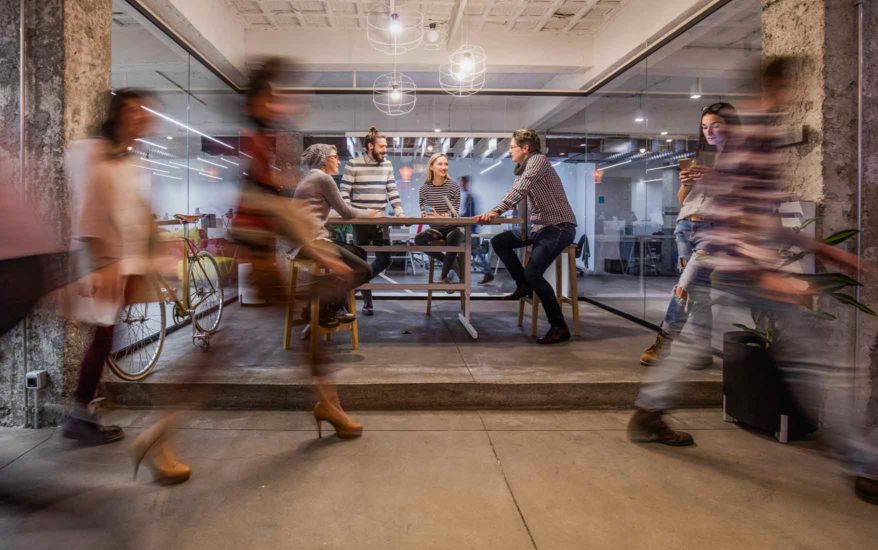
We know what you’re thinking right now. “Here we go, another blog about digital transformation”. Well, don’t worry: we feel your pain. That’s why we want to take a look at it from a different standpoint.
Digital transformation has become one of those fuzzy catch-all business buzzwords that could mean just about anything and everything in this day and age – and yet at the same time, means absolutely nothing. So we thought we’d try and cut through the nonsense and work out what digital transformation really means to businesses this year, especially in the context of their physical working environments.
You don’t need us to tell you that things are changing fast. The pandemic has led to a major change in how businesses operate day-to-day, and flexible working models are increasingly becoming the norm. This shift is posing lots of challenges for organizations as they try to adapt, but instead of trying to make their old methods fit into new ways of working, perhaps digital transformation represents a chance to re-evaluate things more widely?
Here are three talking points which hopefully will give you some food for thought as you search for the most effective way to operate your business flexibly:
A clean sheet of paper
Lots of employees now want to work from home at least some of the time: that’s pretty much a given for most businesses. But if the conventional wisdom of a nine-to-five in the office has been dispensed with, why can’t other conventional wisdoms be dispensed with at the same time?
For example, do employees really need to work five days a week when they can get just as much done – or more – in four? Microsoft Japan trialled a four-day week before the pandemic took hold and found overall productivity rose 40%. Or do you really need all those desks and meeting rooms when hybrid working means they all stand empty half the time? CBRE research suggests overall office demand by 2030 will still be nearly 10% down on pre-pandemic levels, which means there are some big savings to be made, especially for larger companies.
These ideas are just the tip of the iceberg, and the truth is that businesses – within reason! – can apply digital transformation in whatever way they want, so that they can operate however they and their employees want to. Apart from the laws of the land, the freedom to do so is near-total.
The purpose of innovation
It seems like every day, there is a shiny new technology available for businesses. With such a crowded marketplace, it can be difficult to truly understand which ones would be most useful to a particular organization, and whether or not they would work well with their existing solutions and processes. It’s because of this that any new solution taken on must make sense in the context of a business’s future strategy.
In normal times, that strategy could be more or less anything. But in the current climate, it’s clear that businesses need to pivot more towards technology that helps employees rather than those that serve business processes or bottom lines. For example, hybrid workers in particular need to be able to move seamlessly between home and office work with no compromise to their productivity. They’ll be looking for technology that gives them easy access to data and applications wherever they are, or platforms that allow them to reserve workspaces in the office in advance.
Making workplaces smarter
Just as technology and digital transformation can make a big difference for employees, they can make a big difference to physical workspaces, too. This goes far beyond the potential real estate savings mentioned earlier, and reaches into the types of workspace available within a building, the quantities available of each type in order to serve employee demand, and how spaces interconnect with other business functions.
Take a meeting room, for example. Reserving one for 11:30 on Tuesday sounds simple, right? Wrong. You need to invite everyone and make sure they’re all available. You need to ensure Microsoft Teams or Zoom is connected up so virtual attendees can take part – and ensure the room has the required audio-visual hardware to support this. You need to ensure that the external clients visiting know where they’re going when they arrive at your building and need to find the meeting room. You need to book catering facilities so everyone can have lunch, and to be sure that the food will arrive at the time it’s needed.
Technology can help join the dots of all of these considerations, remove the stress from organizing important meetings, and shorten the process of doing so to a matter of minutes. It means workspaces run smarter, employers benefit from successful, professionally organized meetings, and employees are better able to focus on their jobs without being held back by the hassle of admin.
It just goes to show that when you cut through the spin of digital transformation and apply some context and focus, there are some ideas and technologies that can make a real difference.



